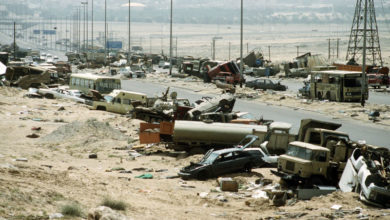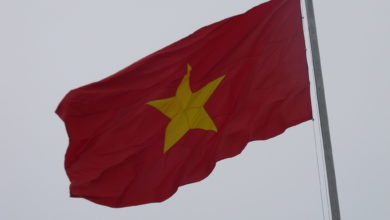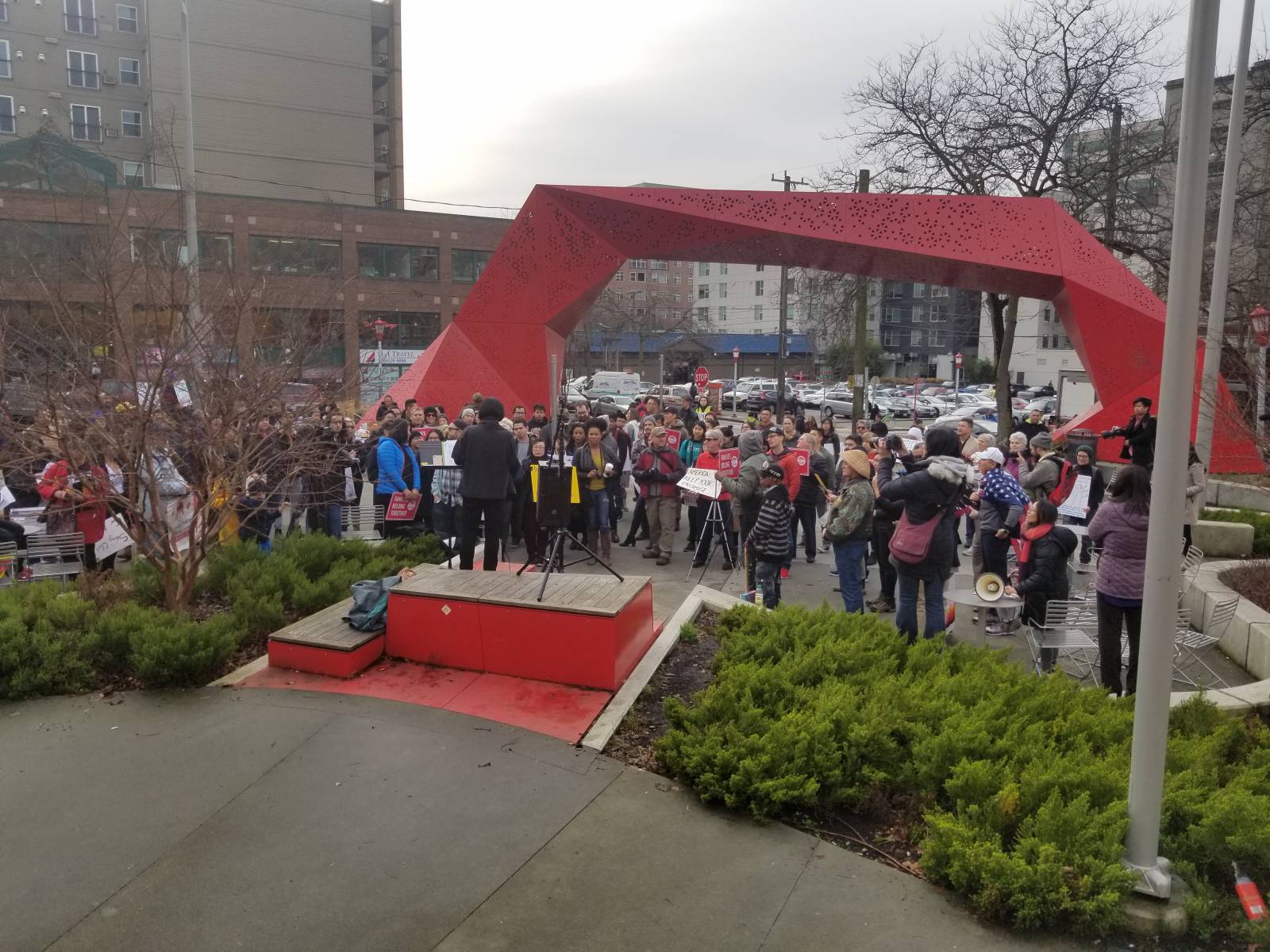 Millions of Vietnamese suffer the effects of U.S. chemical warfare. Photo: jim gensheimer/san jose mercury |
In one sense, the government and people of socialist Vietnam have left the “American War” far behind them in the 30 years since the liberation and reunification of their country in 1975. They are too busy rebuilding Vietnam and working for the future to dwell on the past.
In another sense, however, Vietnam is daily reminded of the traumatic and deadly U.S. imperialist intervention. They are reminded not simply of the millions who died in the war, but also by the continuing legacy of America’s chemical warfare that took place from 1961 to 1975.
The lasting impact of Agent Orange
The U.S. government and its Saigon allies drenched southern Vietnam with at least 20 million gallons of defoliants, 60 percent of which were the notorious Agent Orange, the vehicle for the deadly chemical dioxin. An estimated 4.8 million people were directly exposed to AO, and over a million, “have been seriously poisoned. … Over 150,000 child victims suffer from paralysis, mental retardation, audiovisual impairment and other defects,” including more than 50,000 severe birth deformities. (Viet Nam News Agency)
According to Canada’s Hatfield Consultants Ltd., which conducted a multi-year study in Vietnam, “Nearly 30 years after the cessation of hostilities, dioxin remains at alarmingly high concentrations in soils, foods, human blood and human breast milk.”
In 2003, Dr. Arnold Schecter of the University of Texas conducted soil tests in Vietnam and determined that in some areas the presence of dioxin was 180 million times higher than safety standards allowed. “Even in children never sprayed with Agent Orange,” he said, “dioxin is getting into the Vietnamese people through highly contaminated foods, including ducks, chicken and fish.”
Dr. Pham Viet Thanh of Ho Chi Minh City’s Tu Du Hospital noted that “Agent Orange births are normal for us … [but] every now and then we have what we call a fetal catastrophe—when the number of miscarriages and deformed babies overwhelms us.”
Despite economic growth in recent years, Vietnam is a poor country and has difficulty caring for so many families in need. Hanoi is able to provide AO families with a $20 monthly subsidy.
The Hanoi government has brought Agent Orange to Washington’s attention many times, to no avail. In 2000, for instance, during a visit to Vietnam by President Bill Clinton, Vietnamese President Tran Duc Luong requested that the White House “acknowledge its responsibility to de-toxify former military bases and provide assistance to Agent Orange victims.” Unsurprisingly, Clinton did not honor this request.
On Aug. 10 this year, the people of Vietnam will observe Agent Orange Day—an annual occasion created last year to generate public support for the Association of Victims and their lawsuit. The commemoration marks the beginning of chemical warfare by the United States—Aug. 10, 1961—which took place largely in American-occupied southern Vietnam.
Victims take legal action
Seeking relief, scores of Vietnamese people as well as the Vietnam Association for Victims of Agent Orange/Dioxin initiated a civil suit last year in U.S. federal court against 37 American chemical corporations complicit in the wartime manufacture of defoliants. They filed suit in the eastern district of New York, the court that in 1984 pressured chemical firms to pay $180 million for claims made by thousands of AO-affected GIs.
On March 10, however, Judge Jack Weinstein dismissed the suit, claiming, “The plaintiffs could not prove that AO had caused their illnesses,” and that the use of Agent Orange was not a “violation of the laws of war.” Critics of the decision, which is being appealed to a higher federal court, point out that the judge ignored ample scientific evidence of AO’s health dangers and disregarded international laws against the use of such chemicals in warfare.
Former Vietnamese Vice President Nguyen Thi Binh, now a leader of the Association of Victims, condemned the decision and told the press: “We call on the U.S. to solve the problem with a humanitarian spirit.” The Foreign Ministry declared, “The companies have to bear legal responsibility for all victims of the chemical, not only American veterans.”
A U.S. solidarity organization, the Vietnam Agent Orange Relief and Responsibility Campaign, also denounced the decision, demanding that the U.S. government, “meet its legal and moral responsibility to compensate these victims of Agent Orange.” In concert with the victims’ association, the American group is circulating a petition calling for compensation. It is available at www.vn-agentorange.org.
The decision to poison
In the spring of 1961, President John F. Kennedy’s advisers urged him to deploy chemicals to defoliate vast areas of Vietnam to achieve two objectives: to deprive National Liberation Front guerrillas of concealment in the thick forest and mangroves covering much of the region; and to destroy local rice and other crops that the peasants sold or shared with the liberation fighters.
The first experimental chemical bombardment—in a helicopter with the markings of the South Vietnamese Air Force but piloted by a U.S. soldier—took place near the village of Chon Thanh, north of Saigon.
Over the next months the chemical defoliants proved to be capable of destroying the target vegetation and crops, prompting Defense Secretary Robert McNamara to launch a systematic defoliation campaign in December 1961. As a consequence, an estimated 40 percent of the land that formerly constituted South Vietnam still remains barren, except for grasses.
 The U.S. dropped over 20 million tons of poisonous defoliants on Vietnam during the war. |
The general defoliation program was named “Trail Dust,” and the part devoted to aerial spraying from C-123 airplanes (which accounted for most of the campaign) was called “Ranch Hand.”
Agent Orange wasn’t deployed until 1965, and was only one of several chemicals used. The others were Agents Purple, Green, White, Pink and Blue. These names corresponded to the color painted on the 55-gallon drums containing each substance. The drum with a bright orange band contained 50 percent n-butyl ester of 2,4-D (2,4-dichlorophenoxyacetic acid) and 50 percent n-butyl or isooctyl ester of 2,4,5-T (2,4,5-trichlorophenoxyacetic acid)—that is, Agent Orange.
All the “agents” were toxic, but AO was the most dangerous, accounting for about 60 percent of the spraying. AO contained the most dioxin, which the World Health Organization defines as follows:
“Dioxins are a special group of dangerous chemicals known as persistent organic pollutants. Once dioxins have entered the environment or body, they are there to stay due to their uncanny ability to dissolve in fats and to their rock-solid chemical stability. … In the environment, dioxins tend to bio-accumulate in the food chain. The higher in the food chain one goes, the higher is the concentration of dioxins. … Short-term exposure of humans to high levels of dioxins may result in skin lesions and altered liver function. Long-term exposure is linked to impairment of the immune system, the developing nervous system, the endocrine system and reproductive systems. Chronic exposure can lead to cancer.”
The Veterans Administration added these diseases to the list caused by dioxin: Non-Hodgkin’s lymphoma, soft tissue sarcoma, Hodgkin’s disease, multiple myeloma, respiratory and prostate cancers, and type 2 diabetes.
For 14 years, the chemicals that cause these disabilities were dumped on millions of human beings and all the animals of the forests and mangroves of southern Vietnam. It ended only when the puppet Saigon government fell in 1975.
The U.S. government knew the whole time
The White House and Pentagon were not ignorant of the negative effects of these chemicals.
According to the Vietnamese lawsuit, the Federation of American Scientists expressed opposition to herbicides in Vietnam just three years after the first spraying. They opposed the herbicides on the grounds that the United States was using the war as an opportunity to experiment in biological and chemical warfare.
In January 1966, a group of about 30 Boston scientists protested crop destruction as a barbarous and indiscriminate attack on both combatants and noncombatants. In 1967, a petition signed by more than 5,000 scientists urged President Johnson to stop using antipersonnel and anti-crop chemicals in Vietnam. Also in 1967, the American Association for the Advancement of Science urged the Defense Department to study the long-range ecological consequences of the herbicidal warfare program.
In October of 1967 the RAND Corp., the Pentagon’s principal non-government think-tank, discredited the entire program. First, the program failed to prevent the liberation forces from obtaining rice and concealment. Second, it was causing health problems for civilians in the target areas. Third, it was turning the rural population against the U.S. and Saigon.
By 1969, the UN General Assembly passed a resolution, 83-3 (with the U.S. in the minority), which reminded the world that the 1925 Geneva Protocol outlawed the use of biological or chemical substances in warfare that destroyed plant life. The treaty banned these substances if they harmed humans, plants or animals. In addition, opponents of the AO campaign pointed out that it violated the 1907 Hague Convention, the 1945 Nuremberg Charter and UN Charter, and the 1949 Geneva Convention, which called for the protection of civilians during wartime.
In October 1971, public and political pressure finally succeeded in forcing an official suspension of Operation Trail Dust/Ranch Hand. But the spraying actually continued. Vietnam maintains that Washington turned over its remaining defoliant stores to the Saigon regime, and continued supplying it surreptitiously until the war ended.
War crimes and retribution
The Agent Orange defoliation campaign was a war crime. But it was only part of a string of American war crimes, which lasted 40 years. Washington began interfering in Vietnam during the mid-1950s, when it supported and funded France’s effort to reclaim its Indochinese colonies. It then continued intervening for 20 more murderous years under direct U.S. war management, which took millions of Vietnamese lives, until imperialism was finally defeated. The war was followed by 19 years of sanctions, until Washington finally released its hostile stranglehold in the mid-1990s.
Although the U.S. government will not even entertain the idea of reparations for decades of criminal misconduct toward Vietnam, it might, if faced with enough pressure, consider providing some aid to today’s victims of Agent Orange. This campaign is one that progressives and revolutionaries in the United States and abroad should support. The victims of decades of U.S. crimes in Vietnam deserve justice.




